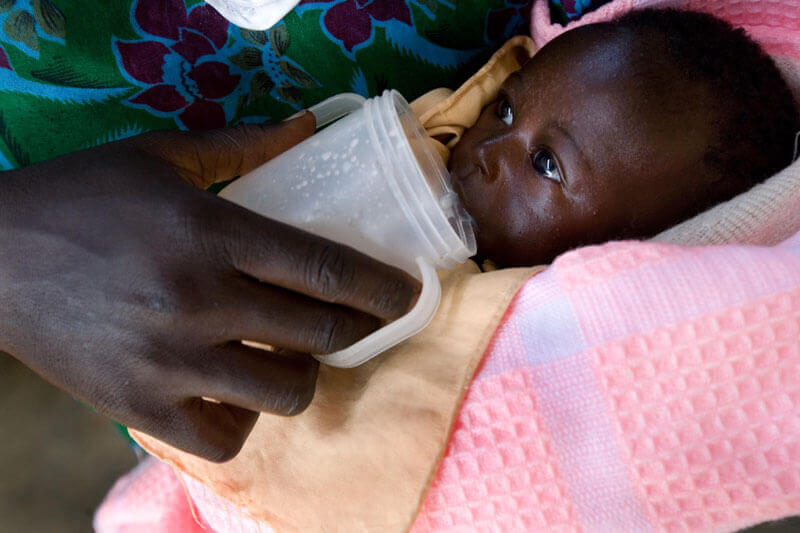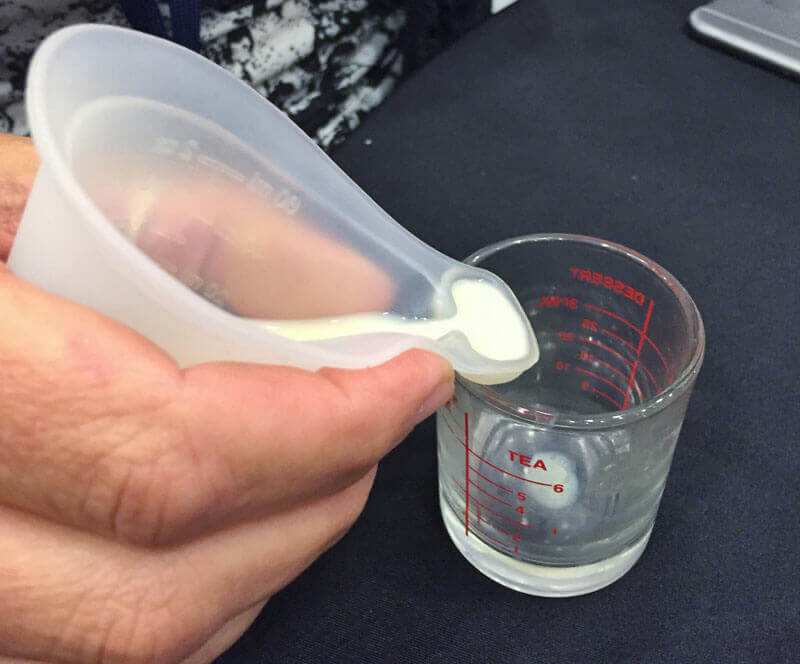
- Many infants have difficulty breastfeeding and must rely on cup feeding. Photo: PATH/Amy MacIver
Breast milk is the perfect first food for newborns; it provides nutrients and energy that infants need and contains substances that strengthen their immune
systems. Ideally, newborns are breastfed within their first hour of life with breastfeeding continuing for their first several months of life.
However, some babies are not able to breastfeed—preterm babies often do not have the fine motor skills and babies born with facial anomalies like
cleft palates cannot breastfeed. And in some cases, babies who are orphaned or have mothers too sick to breastfeed who must be fed with donor milk.
In high-resource settings, these infants could have breast milk fed to them through feeding tubes or specially-designed bottles, but in low-resource settings
these solutions are impractical and often unsafe in areas where reliable clean water is not available. Tubes must be inserted by a trained medical
professional and are often not available in low-resource settings; while bottles are expensive—particularly those that adapted for use by infants
with cleft palates— and difficult for mothers to keep free of bacteria due to their crevices.
For infants in low-resource settings who cannot breastfeed, the World Health Organization recommends hand expression of breast milk and use of a small
cup to feed newborns. Cups are easier to clean so reduce the risk of infection, and cup feeding has been shown in some studies to improve the transition
of preterm infants to exclusive breastfeeding. The problem? There is no cup designed specifically for the job, and the household cups many mothers
use have some serious drawbacks that can put their baby’s health at risk.
A solution? A group of innovators from the University of Washington, Seattle Children’s Hospital Craniofacial Center, and PATH have invented the NIFTY™
cup—a simple-to-use, easy-to-clean, inexpensive cup designed specifically for delivering breast milk to infants.
Your average cup won’t do for breastfeeding
Because there is no standard cup designed for the purpose, mothers who need to cup feed typically use whatever small cups or devices they have on hand.
For example, in India mothers typically use a miniature gravy-boat like device called a paladai—originally used to burn oil during religious
ceremonies—that have sharp-edged metal spouts and can cause oral cuts or injuries to an infant.

- A young infant being cup fed with a mug in Kenya. Photo: PATH/Evelyn Hockstein
In other areas of the world, mothers use coffee mugs, shot glasses, medicines cups, or whatever small cups they can find. Unfortunately, the relatively
wide rims of these cups can make it difficult for a mother to maintain a consistent flow of milk to her newborn which can be problematic and even dangerous.
Too much milk too fast can cause a newborn to aspirate, while too little milk can mean the baby does not get sufficient nutrition. “These infants are
getting an erratic, inconsistent, sometimes too rapid flow [of milk] or not enough access to milk while they are feeding,” explained Christy McKinney,
PhD, MPH, a clinical assistant professor at the University of Washington who helped design the NIFTY™ cup, “So the infants don’t get enough nutrients
within the short amount of time to grow and fight infection.” During lengthy cup feedings, an infant can actually expend more energy trying to feed
than it takes in, which can lead to a rapid decline in health.
Another problem with standard cups is spillage. “About a third of milk is spilled at each feeding, said McKinney, “If you are trying to feed and hand expressing
your breast milk, it’s a pretty painful experience to have a third of that spilled and wasted every time you are feeding, which can be 12 times a day
for a newborn.”
The NIFTY™ cup: a game changer for cup feeding

- A demonstration of feeding using the NIFTY cup. Photo: Marissa Chmiola/GHTC
McKinney and her collaborators kept these drawbacks in mind as they set out to create the perfect cup for cup feeding. The NIFTY™ cup was designed
with a unique reservoir that can hold a bolus of milk at its end. McKinney called this reservoir a “game changer.” It reduces spillage and allows the
milk to be constantly available to the infant. McKinney explained that unlike a spout which only allows milk to be poured into an infant’s mouth, the
unique reservoir of the NIFTY™ cup enables cup feeding to become a two-way street just like traditional breastfeeding or bottle feeding. “The
mother is making sure that the reservoir is filled and then the infant gets to help pace the feed,” said McKinney, “That pacing results in a much calmer
infant. They don’t run the risk of aspirating from too much milk poured into their mouth; instead, they can get the milk they need at the rate they
want it, which allows for a calmer, integrated feeding experience between mother and infant.”
The NIFTY™ cup inventors also made the cup out of silicone, which offers several advantages: The cup is soft and easy to squeeze, it prevents mouth
injuries, it’s durable, and it can be boiled, which makes it easy to sterilize. Because the NIFTY™ has a reservoir that controls the flow of
milk, the cup can be sized much larger than other cups used for cup feeding. This allow mothers to directly hand express the milk into the NIFTY™
cup rather than using multiple cups which in turn reduces spillage and opportunities for contamination. In addition, the NIFTY™ cup contains
tracking markers on the side to monitor milk intake, it’s ergonomically designed for comfort, and it can be affordably produced at less than $1.00
per cup. In short, the NIFTY™ cup offers more advantages for mothers and infants than any other available cup.
The long road to innovation
For McKinney it has been over a five-year odyssey to turn the NIFTY™ cup from idea to reality. Inspired by her time as a Peace Corp volunteer in
Ethiopia and having just completed her PhD studying craniofacial anomalies and beginning her new post-doctoral position, McKinney was looking for ways
she could help children in low-resource settings with oral clefts. She saw feeding as the most problematic area and an area most in need of innovation.
“So I just thought it would be nice to come up with an idea to feed these infants with,” said McKinney. With this concept in mind, McKinney began searching
for a partner who could help make such an idea possible.
She discussed the idea with Dr. Michael Cunningham, the director of the Seattle Children’s Hospital Craniofacial Center, where she completed her PhD, and
they approached GHTC member PATH, based in Seattle. “We reached out to PATH…and there was sufficient interest to say let’s try and make this
work,” said McKinney. Together they developed a design team which included McKinney (an epidemiologist); Dr. Cunningham (a craniofacial pediatrician);
a social scientist, engineer, and commercialization officer from PATH; and an occupational therapist/lactation consultant from Seattle Children’s Hospital.
Together, with funding from PATH and the Seattle Children’s Hospital Craniofacial Center, the team designed their first prototype cup.
A product can only have impact if it meets end-user needs and people are actually interested in obtaining it. To make sure both applied to the NIFTY™
cup prototype, the team set out to test drive the cup in low-resource settings. With support from a nonprofit Transforming Faces—which supports
care for children with oral clefts in South India—and additional funding from the University of Washington CoMotion, McKinney and the team took
the NIFTY™ cup to Sri Ramachandra University in South India to do formative design work in both the cleft center and the Neonatal Intensive Care
Unit. They introduced the cup to mothers and health providers including lactation consultants, watched the product in use, and conducted surveys to
gauge interest in the product and to inform design. The NIFTY™ cup was a big hit. “I was really excited that they liked it more than what they
were using,” said McKinney, “I didn’t quite know what to expect on that, but they are really excited to get it commercialized.”
Armed with valuable feedback from South India, McKinney and the team regrouped and are doing a minor redesign of the product which will be complete this
summer. Last month, the team won a grant from the Saving Lives at Birth Challenge.
With this funding, the NIFTY™ cup developers plan to conduct a clinical study in Ethiopia to evaluate the product’s effectiveness compared to
standard cups being used, and also develop a market shaping strategy for introducing the product.
While it could still be some time before the product is widely available to those who need it, McKinney and the rest of the team are energized by the NIFTY™
cup’s lifesaving potential and the support they are receiving to continue development and introduction. “I’m so excited. This little idea has percolated
so long, and people have finally seen the value it can bring,” said McKinney.



